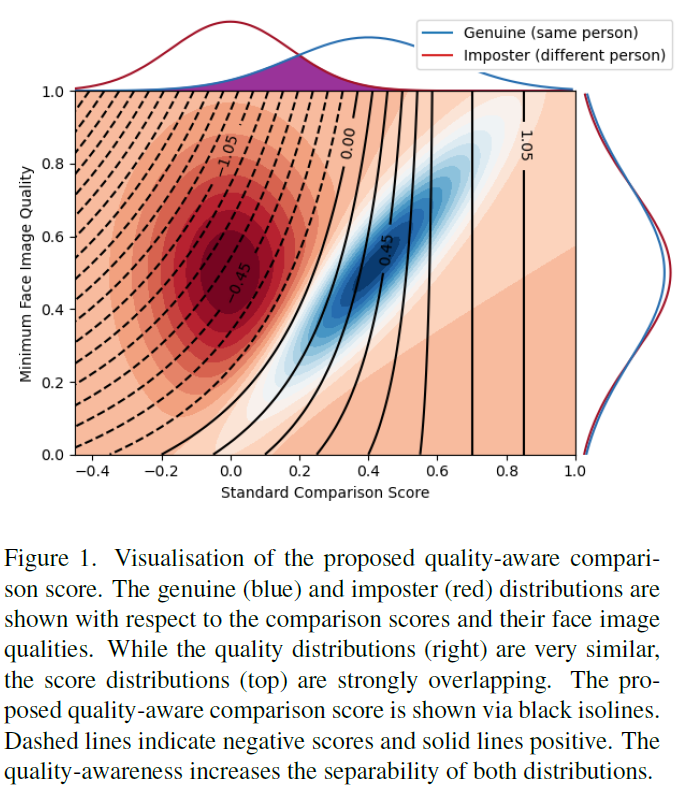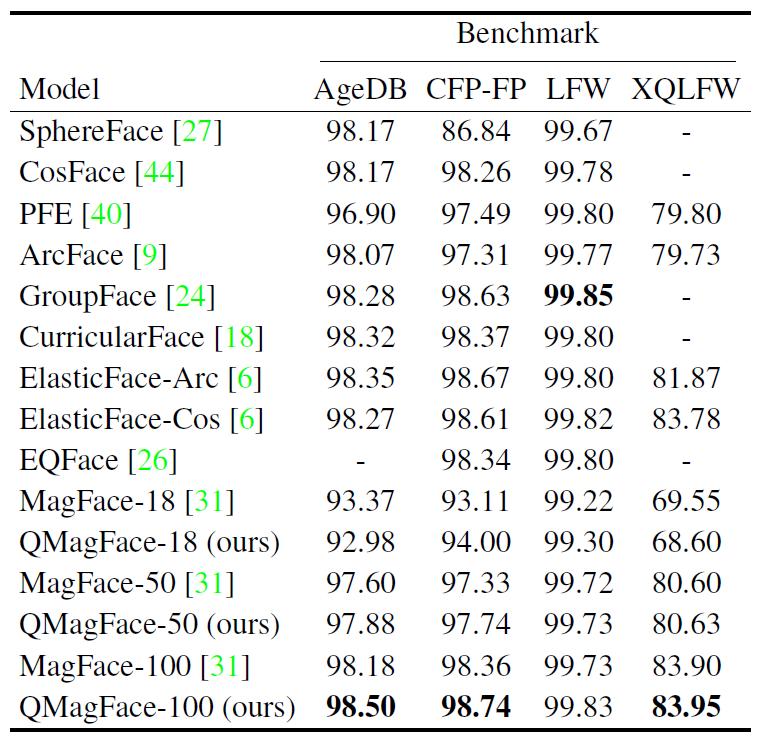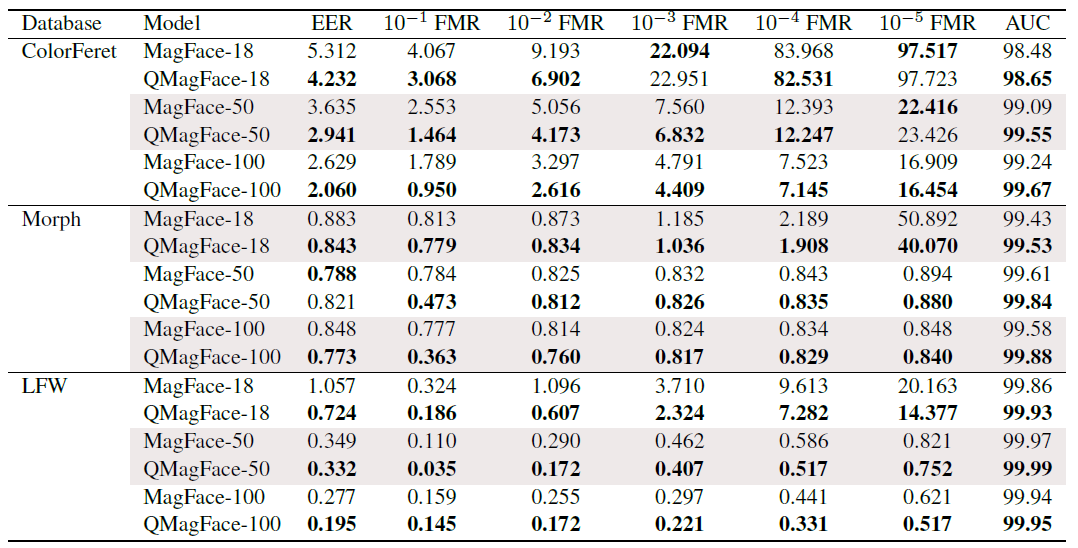Accepted at IEEE/CVF Winter Conference on Applications of Computer Vision (WACV) 2023.
Face recognition systems have to deal with large variabilities (such as different poses, illuminations, and expressions) that might lead to incorrect matching decisions. These variabilities can be measured in terms of face image quality which is defined over the utility of a sample for recognition. Previous works on face recognition either do not employ this valuable information or make use of noninherently fit quality estimates. In this work, we propose a simple and effective face recognition solution (QMag- Face) that combines a quality-aware comparison score with a recognition model based on a magnitude-aware angular margin loss. The proposed approach includes modelspecific face image qualities in the comparison process to enhance the recognition performance under unconstrained circumstances. Exploiting the linearity between the qualities and their comparison scores induced by the utilized loss, our quality-aware comparison function is simple and highly generalizable. The experiments conducted on several face recognition databases and benchmarks demonstrate that the introduced quality-awareness leads to consistent improvements in the recognition performance. Moreover, the proposed QMagFace approach performs especially well under challenging circumstances, such as crosspose, cross-age, or cross-quality. Consequently, it leads to state-of-the-art performances on several face recognition benchmarks, such as 98.50% on AgeDB, 83.95% on XQLFQ, and 98.74% on CFP-FP.
The proposed approach is analysed in three steps. First, we report the performance of QMagFace on six face recognition benchmarks against ten recent state-of-the-art methods in image- and video-based recognition tasks to provide a comprehensive comparison with state-of-the-art. Second, we investigate the face recognition performance of QMagFace over a wide FMR range to show its suitability for a wide variety of applications and to demonstrate that the quality-aware comparison score constantly enhances the recognition performance. Third, we analyse the optimal quality weight over a wide threshold range to demonstrate the robustness of the training process and the generalizability of the proposed approach.
In the following, we will only show some results. For more details and dicussions, please take a look at the paper.
Performance on face recognition benchmarks - The face recognition performance on the four benchmarks is reported in terms of benchmark accuracy (%). The highest performance is marked bold. The proposed approach, QMagFace-100, achieves state-of-the-art face recognition performance, especially in cross-age (AgeDB), cross-pose (CFP-FP), and cross-quality (XQLFW) scenarios. Since the FIQ captures these challenging conditions and the quality values represent the utility of the images for our specific network, the proposed quality-aware comparison score can specifically address the circumstance and their effect on the network. Consequently, it performs highly accurate in the cross-age, cross-pose, and cross-quality scenarios and achieves state-of-the-art performances.
Face recognition performance over a wide range of FMRs - The face recognition performance is reported in terms of FNMR [%] over a wide range of FMRs. The MagFace and the proposed QMagFace approach are compared for three backbone architectures on three databases. The better values between both approaches are highlighted in bold. In general, the proposed quality-aware solutions constantly improve the performance, often by a large margin. This is especially true for QMagFace based on the iResNet-100 backbone.
Robustness analysis - The optimal quality weight for different decision thresholds is reported on four databases. Training on different databases lead to similar linear solutions for the quality-weighting function. The results demonstrate that (a) the choice of a linear function is justified and (b) that the learned models have a high generalizability since the quality-weighting function trained on one database is very similar to the optimal functions of the others.
The environment was tested with an RTX3080 on Windows 11.
- Download our precomputed MagFace embeddings and pairs files from here and extract them in the QMagFace root directory.
- Download the MagFace100 model from here and place it in the
_models/magface_models/directory. The file directory should look something like this:
QMagFace
_data
ijb
pairs
single_images
_models
magface_models
magface_epoch_00025.pth
mtcnn-model
datasets
...
- Create an environment with
conda env create -f environment.yml. If you do not need/want to compute your own aligned images you can remove mxnet. If you do not need to compute embeddings, you can remove pytorch, torchvision and cudatoolkit. - After Creating the environment you might need to run
conda install pandasbefore running the experiments. - If you have your own pairs file, or a database with a special filename format, you can implement your own functions for handling these cases.
Before we can compute embeddings we have to align the images. We tried our best to recreate the same alignment process that was used for MagFace, however in order to recreate the results we had to get the already aligned images from ArcFace. To align the images run
python align_images.py -s path/to/source/images -r path/where/to/save/aligned/images
Once we have a directory with aligned images we can use these images to compute our embeddings. To do so, run
python embed_images.py -s path/to/aligned/images -r directory/where/to/save/embeddings -d dataset_name -m _models/magface_models/magface_epoch_00025.pth
To evaluate the lfw-like benchmarks run launch_experiments.py with --experiments name. For example, to run the single image benchmarks, with training on adience, run
python launch_experiments.py --experiment single_image --train_db adience -t agedb -t calfw -t cfp -t lfw -t xqlfw
Or recompute our results by using the precomputed alpha and beta values
python launch_experiments.py --experiment single_image --alpha 0.077428 --beta 0.125926 -t agedb -t calfw -t cfp -t lfw -t xqlfw
To run the robustness analysis from our paper run
python launch_experiments.py --experiments robustness
To convince yourself that our method runs quickly, run the runtime analysis with
python launch_experiments.py --experiment runtime --train_db adience
For memory consumption check out
python launch_experiments.py --experiment memory --train_db adience
If you use this code, please cite the following paper.
@article{QMagFace,
author = {Philipp Terh{\"{o}}rst and
Malte Ihlefeld and
Marco Huber and
Naser Damer and
Florian Kirchbuchner and
Kiran Raja and
Arjan Kuijper},
title = {{QMagFace}: Simple and Accurate Quality-Aware Face Recognition},
journal = {CoRR},
volume = {abs/2111.13475},
year = {2021},
url = {https://arxiv.org/abs/2111.13475},
eprinttype = {arXiv},
eprint = {2111.13475},
}
If you make use of our implementation based on MagFace, please additionally cite the original .
This research work has been funded by the German Federal Ministry of Education and Research and the Hessen State Ministry for Higher Education, Research and the Arts within their joint support of the National Research Center for Applied Cybersecurity ATHENE. Portions of the research in this paper use the FERET database of facial images collected under the FERET program, sponsored by the DOD Counterdrug Technology Development Program Office. This work was carried out during the tenure of an ERCIM ’Alain Bensoussan‘ Fellowship Programme.
This project is licensed under the terms of the Attribution-NonCommercial 4.0 International (CC BY-NC 4.0) license. Copyright (c) 2021 Fraunhofer Institute for Computer Graphics Research IGD Darmstadt



